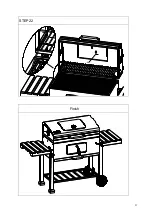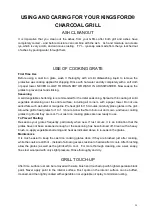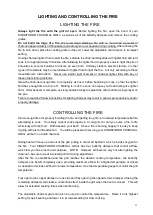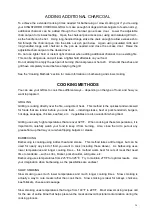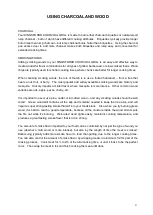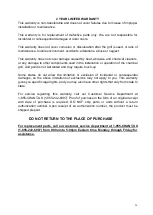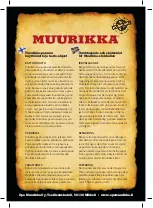
26
ADDING ADDITIONAL CHARCOAL
To achieve the extended cooking times needed for barbecuing or slow smoking (or if you’re using
your KINGSFORD® CHARCOAL GRILL to make enough hot dogs and hamburgers to feed an army),
additional charcoal can be added through the charcoal pan access door. Lower the adjustable
charcoal pan to its lowest setting. Open the charcoal pan access door using an insulated grill mitt –
as the handle can be hot. Using long-handled tongs, stoke the coals enough to allow excess ash to
fall through the charcoal pan into the slide out ash pan below. Again using insulated mitts and
long-handled tongs, add charcoal to the pan as needed and close the access door. Raise the
adjustable charcoal pan to the desired level.
Do not use lighter fluid or instant light charcoal when adding additional charcoal to an existing fire.
This can be dangerous, and will leave a lighter fluid aftertaste on your food.
Do not attempt to empty the ash pan of burning charcoal pieces or hot ash. Wait until the ashes and
grill have completely cooled before emptying the grill.
See the “Cooking Methods” section for more information on barbecuing and slow smoking.
COOKING METHODS
You can use your GRILL to cook three different ways – depending on the type of food, and how you
want to prepare it.
GRILLING
Grilling is cooking directly over the fire, using direct heat. This method is the quickest and works well
for foods that are tender before you cook them – including steaks, beef or pork tenderloin, burgers,
hot dogs, sausages, chicken, seafood, etc. Vegetables are also wonderful when grilled.
Grilling uses very high temperatures that are over 325
F. When cooking at these temperatures, it is
important to carefully watch your food to keep it from burning. Also, close the lid to put out any
grease flare-up that may occur when flipping burgers or steaks.
BARBECUING
Barbecuing is cooking using indirect heat and smoke. This method takes a little longer, but can be
used for nearly any kind of food you want to cook (including those above). As barbecuing uses
lower temperatures and longer cooking times – this method works best for cuts of meat that need
time to tenderize – such as ribs, brisket, pork shoulder, wild game, etc.
Barbecuing uses temperatures from 225
F to 325
F. Try to maintain 275
F for optimal results. Use
your imagination when barbecuing, as the possibilities are endless!
SLOW SMOKING
Slow smoking uses much lower temperatures and much longer cooking times. Slow smoking is
actually a way to cure meats rather than cook them. Slow smoking is ideal for turkeys, chickens,
beef briskets, cheese and sausage.
Slow smoking uses temperatures that range from 140
F to 225
F. Most slow smoking recipes call
for the use of saline brine that helps preserve the meat and avoid bacterial contamination during the
cooking process.
Summary of Contents for BC251
Page 4: ...3 SAVE THIS INSTRUCTION MANUAL FOR FUTURE REFERENCE ...
Page 12: ...11 STEP3 STEP4 A 41 38 A 19 20 37 ...
Page 13: ...12 STEP5 STEP6 E 40 39 29 28 A ...
Page 19: ...18 STEP14 STEP15 A 36 6 ...
Page 20: ...19 STEP 16 STEP 17 B 4 D 3 B 4 D A 11 D D 11 A ...
Page 22: ...21 STEP20 Repeat step 21 to install another side shelf 13 13 C C ...
Page 24: ...23 STEP22 Finish 5 ...












